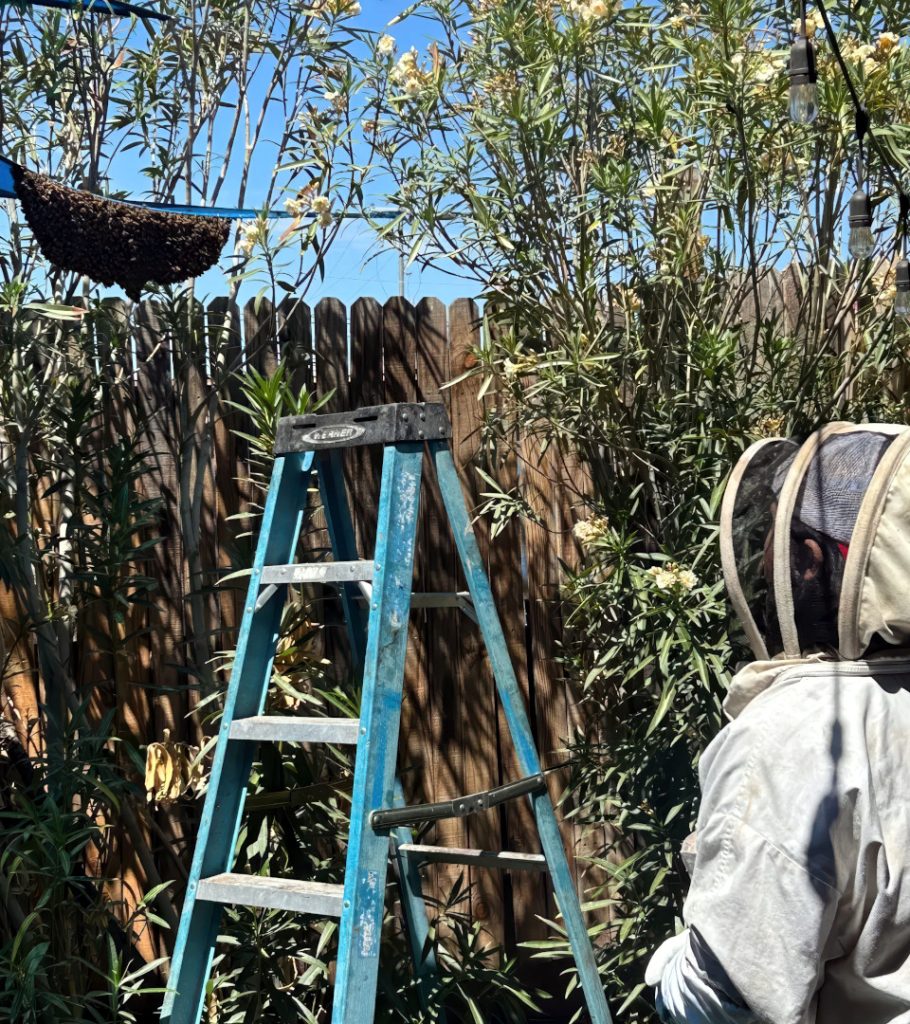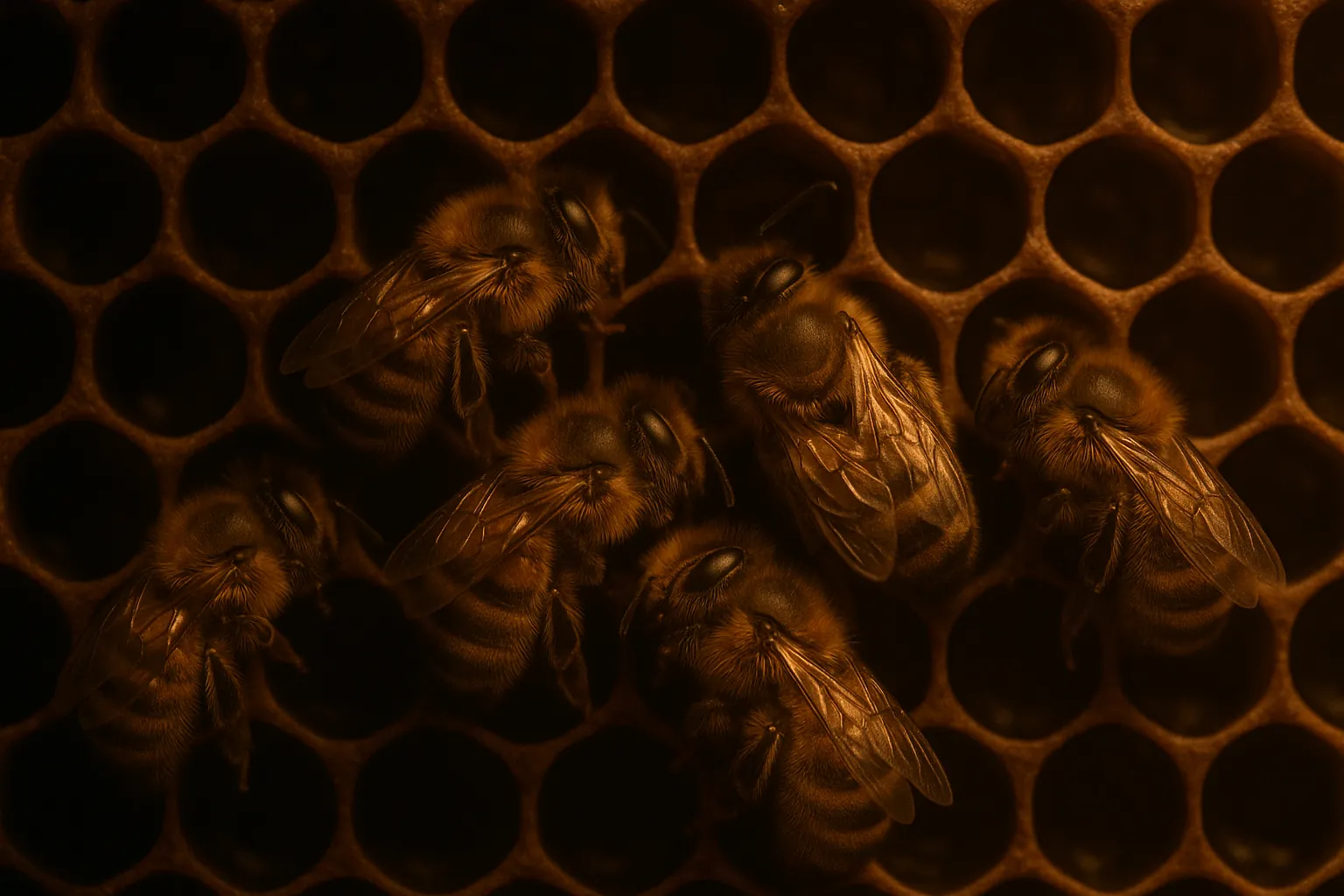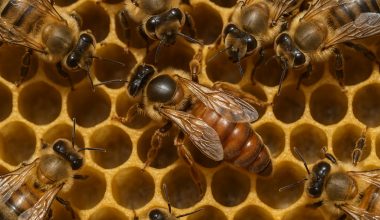If you’re searching for Bee Removal Phoenix because you found bees zipping around your eaves or pooling on a branch, timing matters. Knowing when do bees sleep, when do bees go to sleep, when do bees hibernate, and when do bees go dormant can help you stay safe and make the right call about professional removal.
Phoenix’s Sonoran Desert climate shapes bee behavior in ways that surprise many homeowners: long hot summers, mild winters, and spring blooms mean bees are active for much of the year. Below is a practical guide from Busy Bee Pest Solutions—built from real field experience and optimized for Phoenix conditions.
Quick Answers (for the curious in a hurry)
- When do bees sleep?
Honey bees rest primarily at night. Older foragers show the strongest “sleep” rhythm after sunset inside the hive, while younger nurse bees catnap in shorter cycles throughout the day and night. - When do bees go to sleep in Phoenix?
Most foraging slows dramatically around dusk and resumes shortly after sunrise, with a midday slowdown during extreme heat. Porch and security lights can disorient a few stragglers. - When do bees hibernate?
Honey bees don’t truly hibernate in Phoenix. In colder regions they cluster tightly and conserve energy all winter; here they remain active year-round on warm days, especially during mild winters. - When do bees go dormant?
“Dormant” better describes many native solitary bees (not honey bees). Some enter diapause during drought or cooler seasons, waiting in nests or soil until conditions improve.
Phoenix Day-to-Day Rhythm: How Bees Use the Clock

Think of the hive as a 24-hour factory with rotating shifts:
- Sunrise to late morning: Peak foraging begins as temperatures rise. Nectar- and pollen-rich landscaping (citrus, desert bloomers) draws bees into yards.
- Midday extreme heat: Activity often drops off; foragers conserve energy, ventilate the hive, and avoid lethal dehydration.
- Late afternoon to dusk: A second, smaller foraging window may open as temperatures ease.
- Night: Honey bees sleep inside their hive. Foragers usually rest on wax comb or along edges; nurses (younger workers caring for brood) take shorter naps around the clock.
If you’re seeing clusters of bees on a fence post or tree during daylight, you may be witnessing a temporary swarm—a queen and entourage resting 24–72 hours while scouts find a permanent home. For seasonal context, see Why Do Bees Swarm in Spring? Arizona’s Seasonal Guide to Bee Behavior.
Seasonal Behavior: “Hibernate” vs. “Active” in the Valley
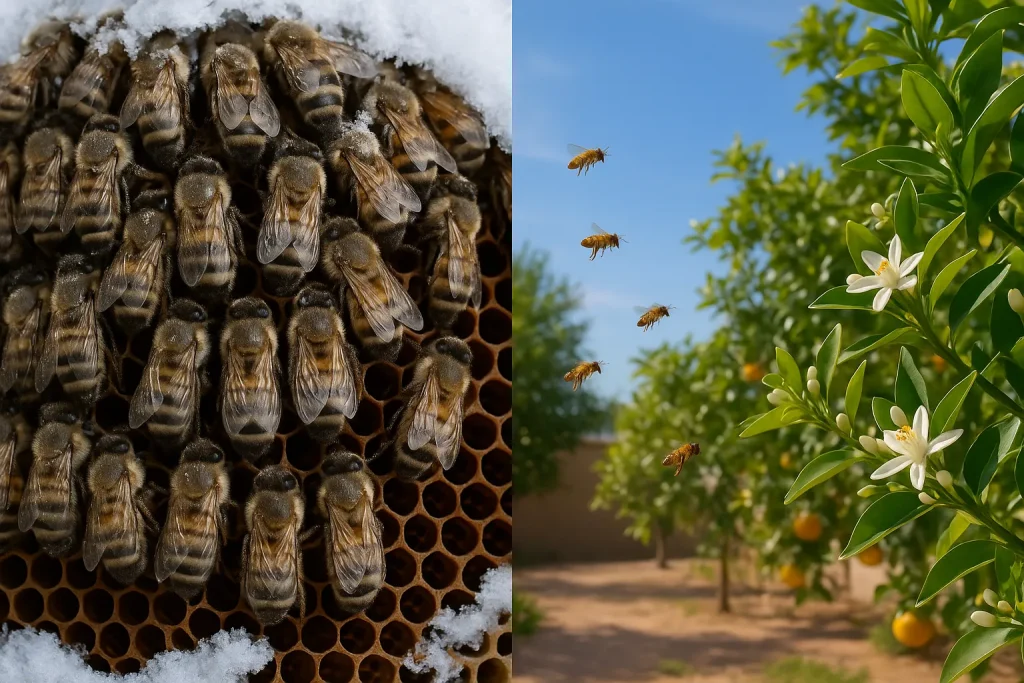
Do honey bees hibernate in Phoenix? Not in the classic sense. Our winters are mild, so colonies stay active—though slower—and the queen often reduces egg-laying when forage is scarce. On cold nights, bees cluster to keep the brood warm, then resume flights as soon as daytime temperatures climb.
By contrast, many solitary native bees (like some ground-nesting species) time their life cycle to the desert’s feast-or-famine pattern. They may go dormant (diapause) in cocoons or underground chambers, waiting for rain or the right temperature window to emerge. That’s a different strategy than honey bees, which survive winter as a colony with stored honey, clustering, and internal climate control.
Want to geek out on the social structure that enables this? We wrote about the royal engine at the center of it all: The Secret Life of the Queen Bee: 10 Fascinating Facts.
Why You Sometimes See Bees at Night
Even though bees sleep at night, homeowners sometimes report:
- A few “confused” bees near porch lights. Artificial lighting can lure late foragers, who then “stall” on walls or patios.
- Buzzing in the walls at odd hours. If lights or indoor warmth spill into a void, bees may shift positions as they regulate temperature. If you suspect a colony inside structure voids, read Bees in Walls (Phoenix): Signs, Risks & How Pros Remove Them Without Wrecking Your Home.
- Night clusters near irrigation or fountains. Bees seek water to cool the hive (evaporative “air-conditioning”). You might see small nighttime gatherings near consistent water sources in hot months.
If your “night bees” are actually a different insect, our Bees vs. Wasps in Phoenix: The Ultimate Homeowner’s Survival Guide can help you tell them apart fast.
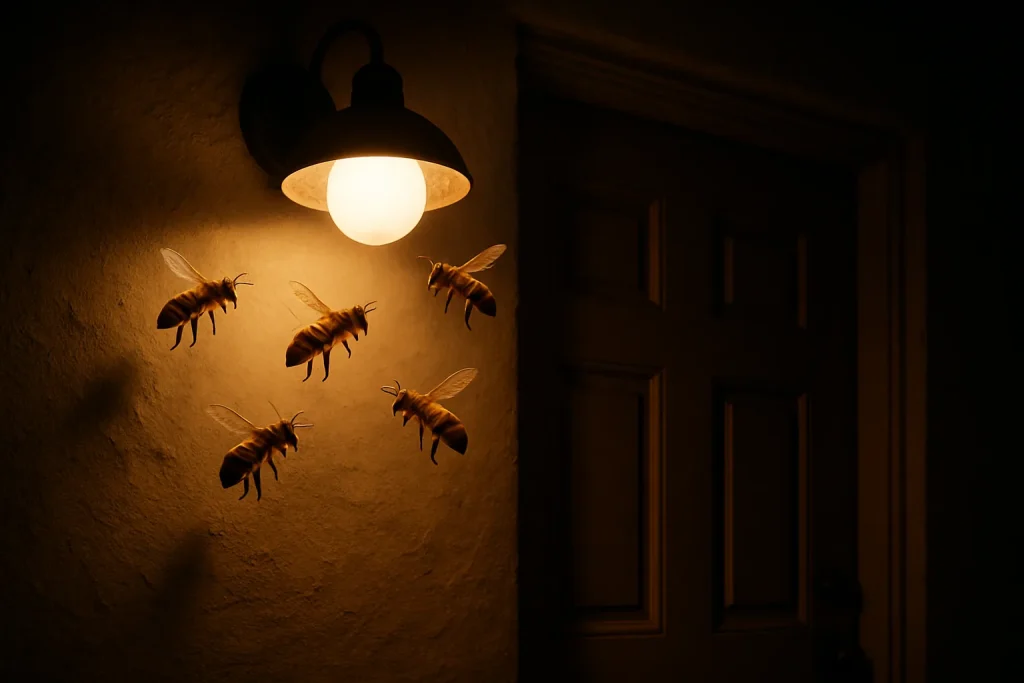
Swarms, “Nap Spots,” and Dormancy Confusion
A daytime swarm cluster can look like a nap or “sleep mode” because the bees are mostly still. But it’s not true sleep or hibernation—it’s a travel layover for a moving colony. Clusters often hang on branches, fence posts, soffits, or block walls.
What to do if a swarm lands in your yard:
Start with Bee Swarm in Your Yard? What to Do (and Not Do) in Phoenix. The main rule: don’t spray and don’t disturb the cluster. Call a pro to evaluate whether it’s moving on or setting up house (especially in shaded voids like block walls and eaves).
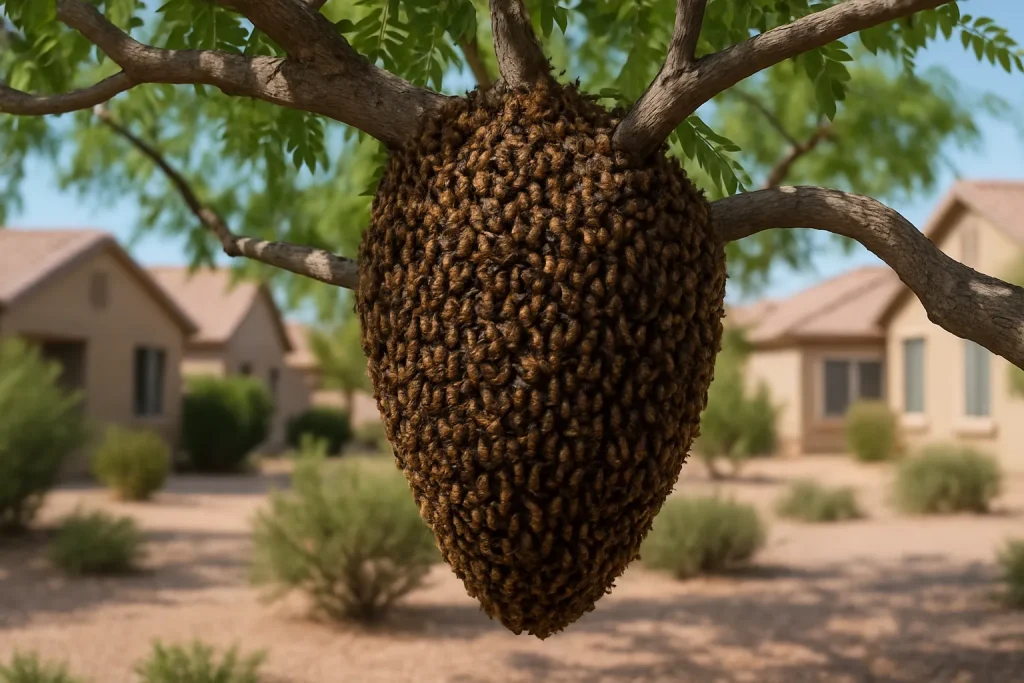
Safety First in Africanized Bee Country
Greater Phoenix is an Africanized honey bee region. While most bees are non-aggressive if left alone, defensive colonies do exist, especially when guarding brood or in cramped voids. If you notice persistent agitation, bees pinging windows, or quick “bump” flights when you walk by, take it seriously and step away.
Our team covers safety and response steps in Survive and Prevent Africanized Bee Attacks in Phoenix: Expert Guide. If pets are part of your household, also bookmark Are Bee Stings Dangerous for Dogs in Arizona? so you’re prepared.
Timing Bee Removal Around Sleep & Activity
Because honey bees sleep at night and cluster in the hive after dusk, removal strategy is often tailored to maximize safety and efficiency:
- Early morning or evening service windows can concentrate bees inside the colony, reducing fly-offs.
- Midday can be appropriate for swarms resting in exposed places (when a queen cluster is reachable and calm).
- Structural colonies (in walls, roofs, sheds) require specialized techniques regardless of hour; activity cycles help plan the safest approach.
For what goes into a professional job, check Bee Hive Removal Near Me in Phoenix: What Every Homeowner Needs to Know. Curious about pricing? We break down factors like access, colony size, and structural repairs in How Much Does Bee Removal Cost in Phoenix? (2025 Guide).
Phoenix Homeowner FAQs
When do bees sleep?
Honey bees sleep mostly at night inside the hive. Foragers follow a strong day-night rhythm, while nurse bees take shorter naps throughout the day and night as they care for brood. In scorching Phoenix summers, you’ll see additional midday slowdowns.
When do bees go to sleep?
In the Valley, foraging typically winds down at dusk, resumes after sunrise, and eases during triple-digit heat. Light pollution can delay a few individuals; if you find lingering bees around porch lights, simply avoid swatting and let them settle or call us for guidance.
When do bees hibernate?
Honey bees don’t truly hibernate in Phoenix. During cooler spells they may cluster tighter and fly less, but our mild winters allow many flight days. In colder climates, honey bees cluster for long periods and may pause brood rearing until temperatures rise.
When do bees go dormant?
“Dormant” best fits solitary native bees that pause in soil or stems during drought or winter (a state called diapause). Honey bees, being social, ride out lean seasons as a colony by conserving energy, clustering, and using stored honey.
Why Understanding Sleep Helps You Avoid Costly Damage
A small swarm resting on your tree today can become a full structural colony tomorrow if it moves into your eaves, block wall, or shed. Once established, bees build wax comb, store honey, and raise brood—turning a simple relocation into a structural repair job. We cover the warning signs and non-destructive removal approach in Bees in Walls (Phoenix): Signs, Risks & How Pros Remove Them Without Wrecking Your Home.
For a reality check on how fast things escalate, scroll our field notes in Top 10 Craziest Bee Removals in Phoenix (You Have to See These).
Respect for Bees, Zero Tolerance for Risk
Busy Bee Pest Solutions is known for live bee removal when conditions allow—and for decisive, safe solutions when they don’t. Bees are critical pollinators (ever enjoy California almonds? Learn why bees power that crop in The Buzz Behind Your Almonds). But when a colony endangers your family, pets, or neighbors, professional removal is the right call.
The Bottom Line for Phoenix
- Sleep: Honey bees sleep at night in the hive; activity peaks mornings and late afternoons, with heat-lulls midday.
- Hibernate: Not in Phoenix—expect year-round activity punctuated by slowdowns.
- Dormant: A term better suited to solitary natives in diapause, not honey bee colonies.
- Action: If you see a swarm or suspect bees in a structure, timing your call can reduce risk and cost.
Need Bee Removal in Phoenix Today?
Call Busy Bee Pest Solutions for safe, fast, professional service. We’ll assess whether you’re seeing a resting swarm, a developing colony, or a defensive hive—and handle it safely, often same day.
📞 623-289-3375 — Call now for Bee Removal Phoenix.
Prefer to read up first? Start here:
- Bee Swarm in Your Yard? What to Do (and Not Do) in Phoenix
- Bee Hive Removal Near Me in Phoenix
- How Much Does Bee Removal Cost in Phoenix? (2025 Guide)
Busy Bee Pest Solutions — local experts, respectful of bees, relentless about safety.
